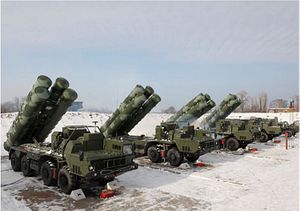New Delhi and Moscow are holding talks to locally manufacture components of the Russian-made Almaz-Antei S-400 Triumf air defense systems (NATO reporting name: SA-21 Growler) in India, according to the head of Russian state-run corporation Rostec.
Rostec head Sergey Chemezov told Russian media on Sunday that a similar agreement over the local production of S-400 already exists with Turkey and that it is “quite possible” for Ankara to locally produce “certain components” of the air defense system.
“Yes, we are discussing the localization of S-400 production with India as well,” Chemezov was quoted as saying by Russian broadcaster RBK. The defense industry official refused to specify which components of the S-400 could be produced in India.
He added that India is already license-producing Russian Su-30 fighter jets and the T-90 tanks.
“We have developed the BrahMos missiles with them [India]–on their territory and together with their scientists,” he also noted.
The BrahMos is a derivative of the Russian-made P-800 Oniks over-the-horizon supersonic anti-ship cruise missile and is thought to be one of the world’s fastest cruise missiles currently in operational use.
In recent years, India has been incrementally indigenizing a number of subsystems of the missile, including a new seeker and missile booster. Russia still supplies the BrahMos’ ramjet propulsion system and seeker technology, with India contributing the inertial navigation system and fire control system.
The S-400 can be armed with a host of different missiles including the air defense system’s most advanced interceptor, the 40N6E, in addition to an improved variant of the 48N6E2, as well as the 9M96E and 9M96E2. It has not been publicly disclosed what missiles Russia will deliver to India along with the transporter erector launchers (TELs), long-range surveillance radar target acquisition and engagement (fire control) radar systems, and command posts to be delivered.
India could decide to fit at least some of the Russian-made interceptors with indigenous technology, but it is unclear to what degree Russia will allow the integration of these Indian subsystems on the missiles. The Indian government has also not confirmed that producing some S-400 components locally in India, as claimed by Chemezov, is seriously under consideration or has indeed been subject of discussion between the two countries.
India and Russia signed a $5.5 billion contract for five S-400 squadrons for service in the Indian Air Force during the 2018 bilateral summit between the two countries.
The United States has threatened sanctions against India for the procurement of the Russian weapons systems under U.S. legislation known as the Countering America’s Adversaries Through Sanctions Act (CAATSA).
Washington has reportedly offered the Indian military the MIM-104F Patriot (PAC-3) surface-to-air missile defense system and the Terminal high Altitude Area Defense (THAAD) system as a replacement for the S-400, yet India has persisted in its decision to purchase Russian-made long-range air defense systems.
































